A Wearable Dual-Band Magnetoelectric Dipole Rectenna for Radio Frequency Energy Harvesting
Abstract
1. Introduction
2. Characterization of the High CGFs
3. Antenna Design
3.1. Antenna Configuration and Operating Mechanisms
3.2. Design Process and Parametric Study
3.3. Results and Discussion
4. Rectenna System
4.1. Rectifier Configuration
4.2. Fabrication Prototype and Measured Results
5. Conclusions
Author Contributions
Funding
Data Availability Statement
Conflicts of Interest
References
- Costanzo, A.; Masotti, D. Energizing 5G: Near- and Far-Field Wireless Energy and Data Trantransfer as an Enabling Technology for the 5G IoT. IEEE Microw. Mag. 2017, 18, 125–136. [Google Scholar]
- Niu, S.; Matsuhisa, N.; Beker, L.; Li, J.; Wang, S.; Wang, J.; Jiang, Y.; Yan, X.; Yun, Y.; Burnett, W.; et al. A wireless body area sensor network based on stretchable passive tags. Nat. Electron. 2019, 2, 361–368. [Google Scholar]
- Rosso, M. Intentional and Inherent Nonlinearities in Piezoelectric Energy Harvesting; Springer Nature: Cham, Switzerland, 2024. [Google Scholar]
- Song, K.; Bonnin, M.; Traversa, F.L.; Bonani, F. Broadband vibration energy harvesting using nonlinear multi degree-of-freedom mechanical filters. In Nonlinear Dynamics; Springer: Berlin/Heidelberg, Germany, 2025. [Google Scholar]
- Wagih, M.; Balocchi, L.; Benassi, F.; Carvalho, N.B.; Chiao, J.; Correia, R.; Costanzo, A.; Cui, Y.; Georgiadou, D.; Gouveia, C.; et al. Microwave-Enabled Wearables: Underpinning Technologies, Integration Platforms, and Next-Generation Roadmap. IEEE J. Microw. 2023, 3, 193–226. [Google Scholar]
- Ullah, M.A.; Keshavarz, R.; Abolhasan, M.; Lipman, J.; Esselle, K.P.; Shariati, N. A Review on Antenna Technologies for Ambient RF Energy Harvesting and Wireless Power Transfer: Designs, Challenges and Applications. IEEE Access 2022, 10, 17231–17267. [Google Scholar]
- Muhammad, S.; Tiang, J.J.; Wong, S.K.; Rambe, A.H.; Adam, I.; Smida, A.; Waly, M.I.; Iqbal, A.; Abubakar, A.S.; Mohd Yasin, M.N. Harvesting Systems for RF Energy: Trends, Challenges, Techniques, and Tradeoffs. Electronics 2022, 11, 959. [Google Scholar]
- Liao, L.; Li, Z.; Tang, Y.; Chen, X. Dual-Polarized Stacked Patch Antenna for Wireless Communication Application and Microwave Power Transfer. Electronics 2021, 10, 2988. [Google Scholar]
- Nusrat, T.; Roy, S.; Lotfi-Neyestanak, A.A.; Noghanian, S. Far-Field Wireless Power Transfer for the Internet of Things. Electronics 2023, 12, 207. [Google Scholar]
- Fernandez-Munoz, M.; Missous, M.; Sadeghi, M.; Lopez-Espi, P.L.; Sanchez-Montero, R.; Martinez-Rojas, J.A.; Diez-Jimenez, E. Fully Integrated Miniaturized Wireless Power Transfer Rectenna for Medical Applications Tested inside Biological Tissues. Electronics 2024, 13, 3159. [Google Scholar]
- Jing, J.; Yang, B.; Yan, L.; Shinohara, N.; Liu, C. Fully Polarized Wideband Omnidirectional RF Harvester with Highly Efficient DC Power Combination. Electronics 2024, 13, 4891. [Google Scholar]
- Deng, X.; Yang, P.; Chen, S.; Ren, W. Design of a 2.4 & 5.8 GHz Efficient Circularly Polarized Rectenna for Wireless Power Transfer Applications. Electronics 2023, 12, 2645. [Google Scholar]
- Yu, B.; Wang, Z.; Ju, L.; Zhang, C.; Liu, Z.; Tao, L.; Lu, W. Flexible and Wearable Hybrid RF and Solar Energy Harvesting System. IEEE Trans. Antennas Propag. 2022, 70, 2223–2233. [Google Scholar]
- Zhang, J.; Wang, Y.; Song, R.; Kou, Z.; He, D. Highly Flexible Graphene-Film-Based Rectenna for Wireless Energy Harvesting. Energy Environ. Mater. 2024, 7, e12548. [Google Scholar]
- Chen, Z.; Song, C.; Zhang, J.; Zheng, X.; Volskiy, V.; Chu, P.; Vandenbosch, G.A.E. Wearable Rectenna With Integrated Miniaturized Feeding Slot and Rectifier Structure. IEEE Trans. Antennas Propag. 2023, 71, 3868–3881. [Google Scholar]
- Fernández, M.; Vázquez, C.; Ver Hoeye, S. 2.4 GHz Fully Woven Textile-Integrated Circularly Polarized Rectenna for Wireless Power Transfer Applications. IEEE Access 2024, 12, 89836–89844. [Google Scholar]
- Lopez-Garde, J.; Del-Rio-Ruiz, R.; Legarda, J.; Rogier, H. 2 × 2 Textile Rectenna Array with Electromagnetically Coupled Microstrip Patch Antennas in the 2.4 GHz WiFi Band. Electronics 2021, 10, 1447. [Google Scholar]
- Patil, D.D.; Subramanian, K.S.; Pradhan, N.C. 3-D-Printed Dual-Band Rectenna System for Green IoT Application. IEEE Trans. Circuits Syst. II Express Briefs 2023, 70, 2864–2868. [Google Scholar] [CrossRef]
- Sang, J.; Qian, L.; Wang, X.; Shi, G. A dual-band omnidirectional rectenna for radio-frequency energy harvesting applications. Microelectron. J. 2025, 156, 106533. [Google Scholar] [CrossRef]
- Erman, F.; Koziel, S.; Zyoud, A.; Leifsson, L.; Ullah, U.; Alkaraki, S. Power Transmission for Millimeter-Wave Indoor/Outdoor Wearable IoT Devices Using Grounded Coplanar Waveguide-Fed On-Body Antenna. IEEE Access 2025, 13, 14063–14072. [Google Scholar] [CrossRef]
- Wagih, M.; Weddell, A.S.; Beeby, S. Omnidirectional Dual-Polarized Low-Profile Textile Rectenna with Over 50% Efficiency for Sub-μ W/cm2 Wearable Power Harvesting. IEEE Trans. Antennas Propag. 2021, 69, 2522–2536. [Google Scholar]
- Wagih, M.; Komolafe, A.; Weddell, A.S.; Beeby, S. Broadband Compact Substrate-Independent Textile Wearable Antenna for Simultaneous Near- and Far-Field Wireless Power Transmission. IEEE Open J. Antennas Propag. 2022, 3, 398–411. [Google Scholar]
- Eid, A.; Hester, J.G.D.; Costantine, J.; Tawk, Y.; Ramadan, A.H.; Tentzeris, M.M. A Compact Source–Load Agnostic Flexible Rectenna Topology for IoT Devices. IEEE Trans. Antennas Propag. 2020, 68, 2621–2629. [Google Scholar]
- Du, C.; Cheng, F.; Yang, Y.; Zhu, H.; Gu, C. Omnidirectional Flexible Tri-Band Rectenna with Eliminated Matching Circuit for Ambient RF Energy Harvesting. IEEE Trans. Microw. Theory Tech. 2025, 73, 674–686. [Google Scholar]
- Wang, C.; Zhang, J.; Bai, S.; Chang, D.; Duan, L. A Multiband Compact Flexible Energy Collector for Wearable or Portable IoT Devices. IEEE Antennas Wirel. Propag. Lett. 2023, 22, 1164–1168. [Google Scholar]
- Ha, T.D.; Nie, X.; Akinsolu, M.; Liu, B.; Chen, P. An Artificial-Intelligence-Assisted Optimization of Imperceptible Multimode Rectenna. IEEE Antennas Wirel. Propag. Lett. 2024, 23, 3559–3563. [Google Scholar] [CrossRef]
- Wagih, M.; Hilton, G.S.; Weddell, A.S.; Beeby, S. Broadband Millimeter-Wave Textile-Based Flexible Rectenna for Wearable Energy Harvesting. IEEE Trans. Microw. Theory Tech. 2020, 68, 4960–4972. [Google Scholar]
- Adami, S.; Proynov, P.; Hilton, G.S.; Yang, G.; Zhang, C.; Zhu, D.; Li, Y.; Beeby, S.P.; Craddock, I.J.; Stark, B.H. A Flexible 2.45-GHz Power Harvesting Wristband with Net System Output From −24.3 dBm of RF Power. IEEE Trans. Microw. Theory Tech. 2018, 66, 380–395. [Google Scholar]
- Yahya Alkhalaf, H.; Ahmad, M.Y.; Ramiah, H.; Zakir Hossain, A.K.M.; Kayser Azam, S.M.; Thiha, A. Flexible Meta-Patch Rectenna Array for Energizing Low-Power Wearable Medical Sensors. IEEE Access 2024, 12, 121570–121585. [Google Scholar]
- Sanusi, O.M.; Ghaffar, F.A.; Shamim, A.; Vaseem, M.; Wang, Y.; Roy, L. Development of a 2.45 GHz Antenna for Flexible Compact Radiation Dosimeter Tags. IEEE Trans. Antennas Propag. 2019, 67, 5063–5072. [Google Scholar]
- Battistini, G.; Paolini, G.; Costanzo, A.; Masotti, D. A Novel 3-D Printed Dual-Port Rectenna for Simultaneous Energy Harvesting and Backscattering of a Passively Generated UWB Pulse. IEEE Trans. Microw. Theory Tech. 2024, 72, 812–821. [Google Scholar] [CrossRef]
- Shah, I.A.; Zada, M.; Shah, S.A.A.; Basir, A.; Yoo, H. Flexible Metasurface-Coupled Efficient Wireless Power Transfer System for Implantable Devices. IEEE Trans. Microw. Theory Tech. 2024, 72, 2534–2547. [Google Scholar] [CrossRef]
- Lin, W.; Ziolkowski, R.W. Electrically Small, Single-Substrate Huygens Dipole Rectenna for Ultracompact Wireless Power Transfer Applications. IEEE Trans. Antennas Propag. 2021, 69, 1130–1134. [Google Scholar]
- Tang, D.; Wang, Q.; Wang, Z.; Liu, Q.; Zhang, B.; He, D.; Wu, Z.; Mu, S. Highly sensitive wearable sensor based on a flexible multilayer graphene film antenna. Sci. Bull. 2018, 63, 574–579. [Google Scholar]
- Song, R.; Zhao, X.; Wang, Z.; Fu, H.; Han, K.; Qian, W.; Wang, S.; Shen, J.; Mao, B.; He, D. Sandwiched Graphene Clad Laminate: A Binder-Free Flexible Printed Circuit Board for 5G Antenna Application. Adv. Eng. Mater. 2020, 22, 2000451. [Google Scholar]
- Song, R.; Mao, B.; Wang, Z.; Hui, Y.; Zhang, N.; Fang, R.; Zhang, J.; Wu, Y.; Ge, Q.; Novoselov, K.S.; et al. Comparison of copper and graphene-assembled films in 5G wireless communication and THz electromagnetic-interference shielding. Proc. Natl. Acad. Sci. USA 2023, 120, e2209807120. [Google Scholar] [CrossRef]
- Xu, R.; Shen, Z. Wearable Ungrounded Tag Antenna for UHF RFID Applications. IEEE Trans. Antennas Propag. 2023, 71, 3665–3670. [Google Scholar]
- Marrocco, G. RFID Antennas for the UHF Remote Monitoring of Human Subjects. IEEE Trans. Antennas Propag. 2007, 55, 1862–1870. [Google Scholar]
- Vital, D.; Bhardwaj, S.; Volakis, J.L. Textile-Based Large Area RF-Power Harvesting System for Wearable Applications. IEEE Trans. Antennas Propag. 2020, 68, 2323–2331. [Google Scholar] [CrossRef]
- Stuchly, M.A.; Stuchly, S.S. Dielectric properties of biological substances-tabulated. J. Microw. Power 1980, 15, 19–26. [Google Scholar]
- Song, C.; Huang, Y.; Zhou, J.; Carter, P.; Yuan, S.; Xu, Q.; Fei, Z. Matching Network Elimination in Broadband Rectennas for High-Efficiency Wireless Power Transfer and Energy Harvesting. IEEE Trans. Ind. Electron. 2017, 64, 3950–3961. [Google Scholar]
- Huang, Y.; Boyle, K. Antennas: From Theory to Practice; John Wiley & Sons: Chichester, UK, 2008. [Google Scholar]
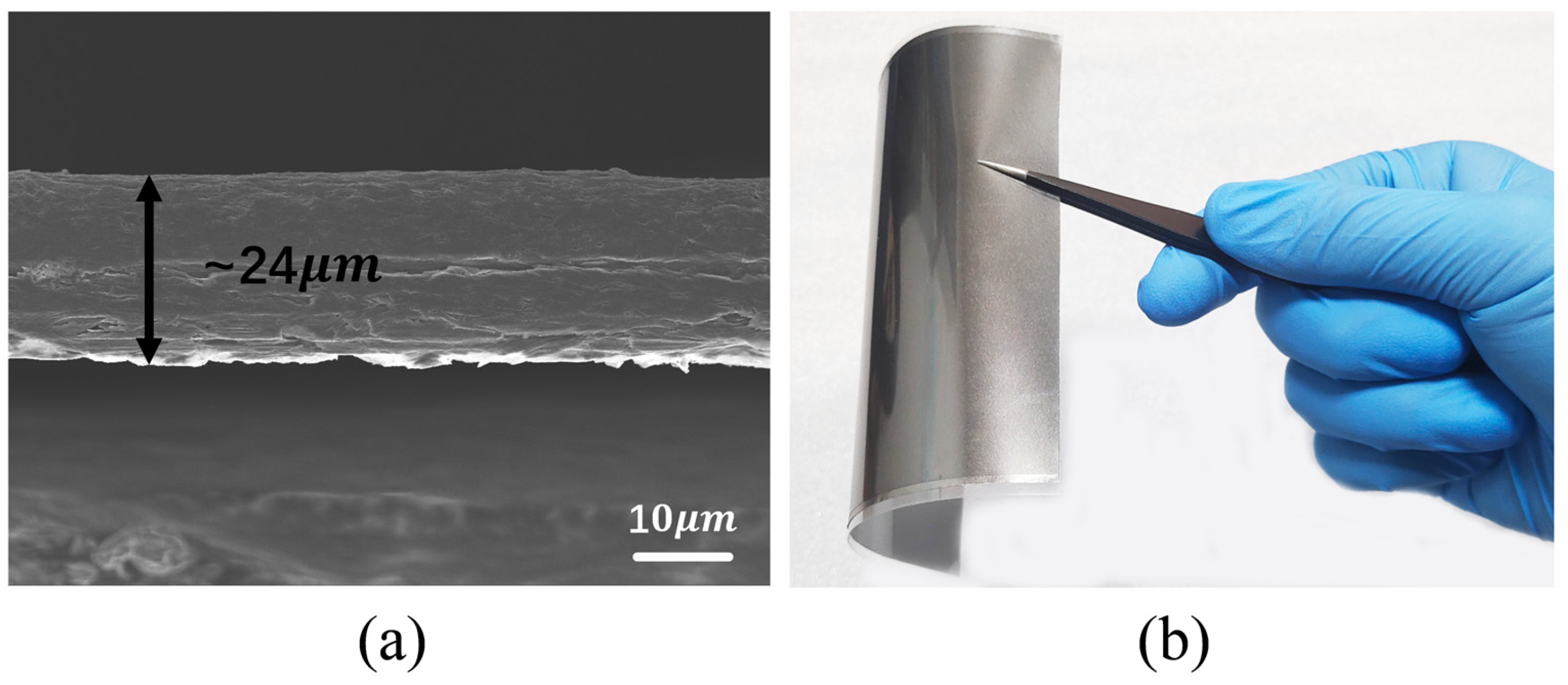


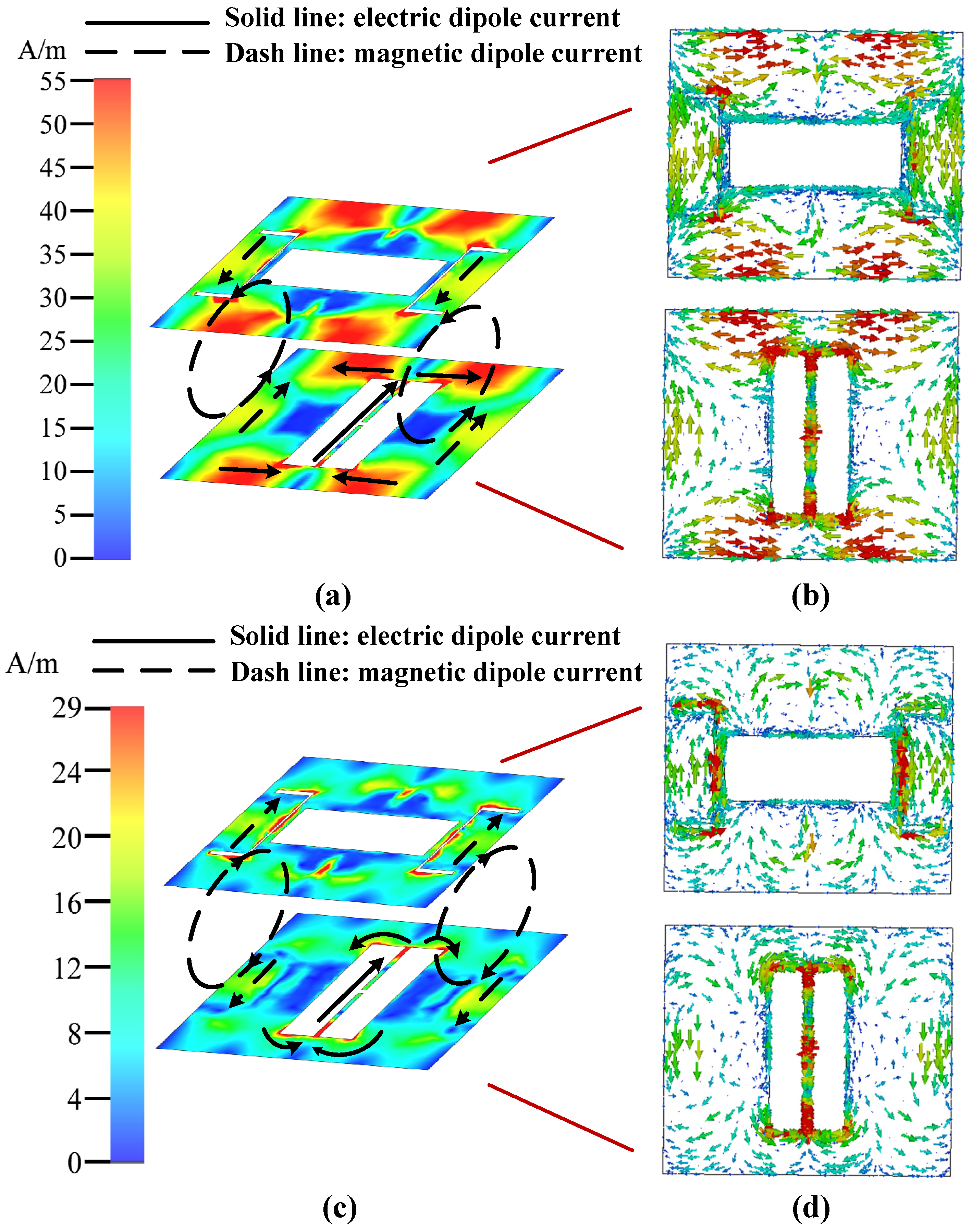
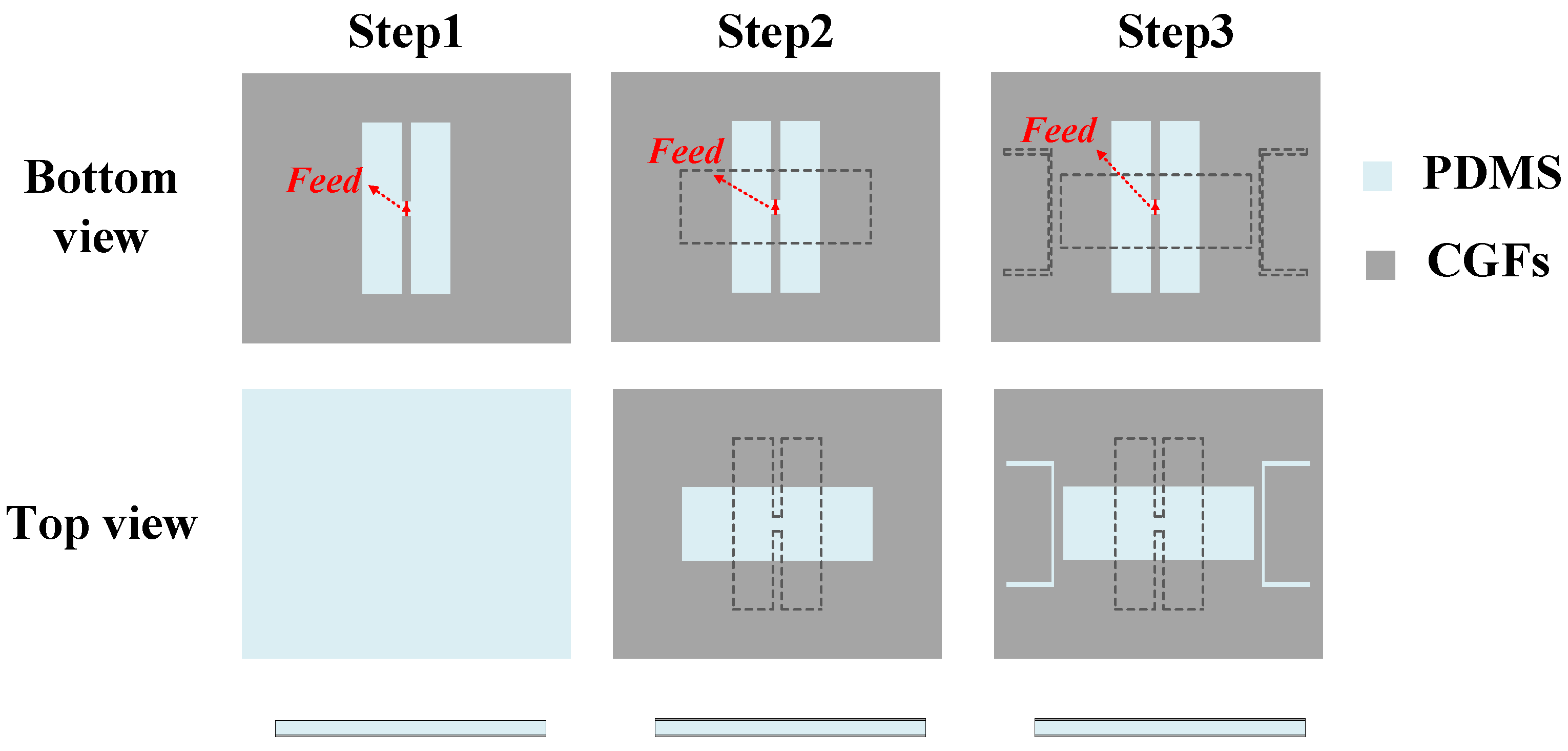
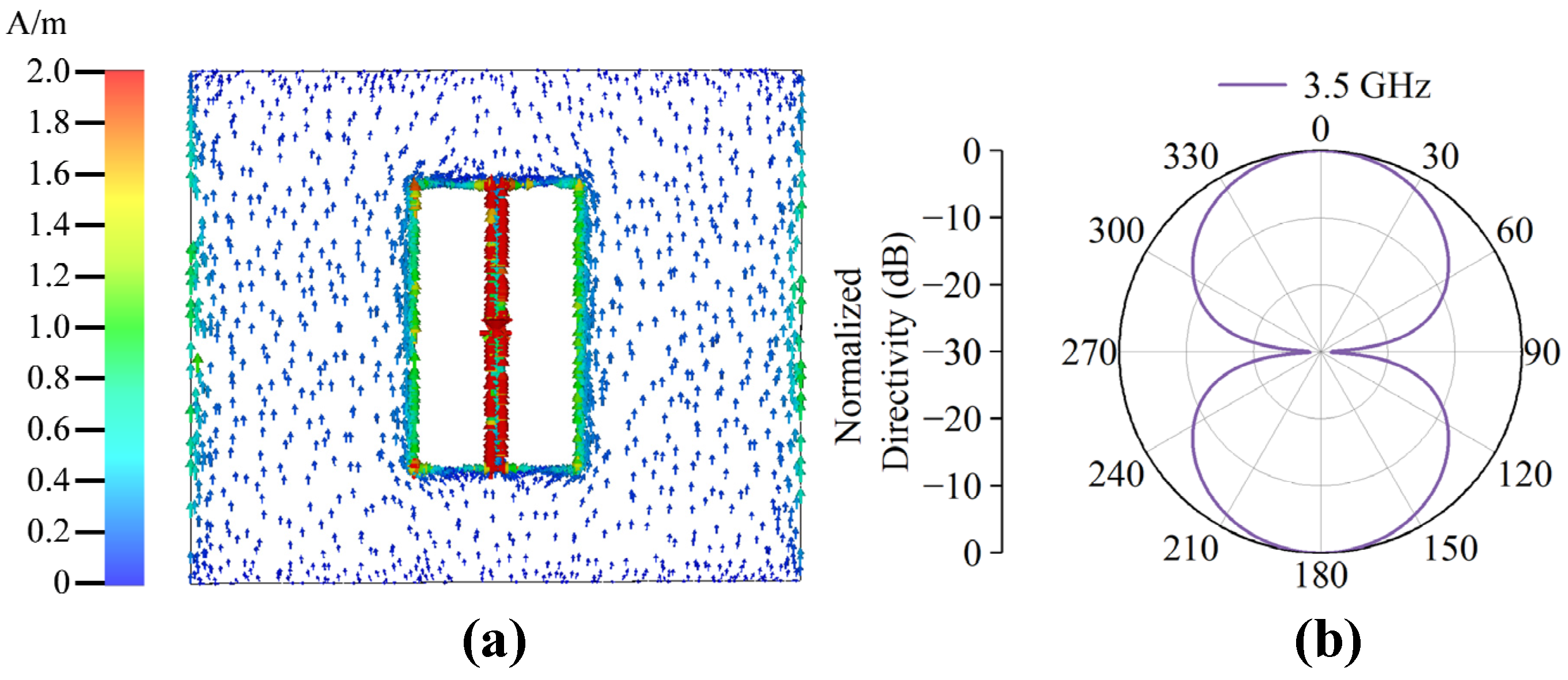
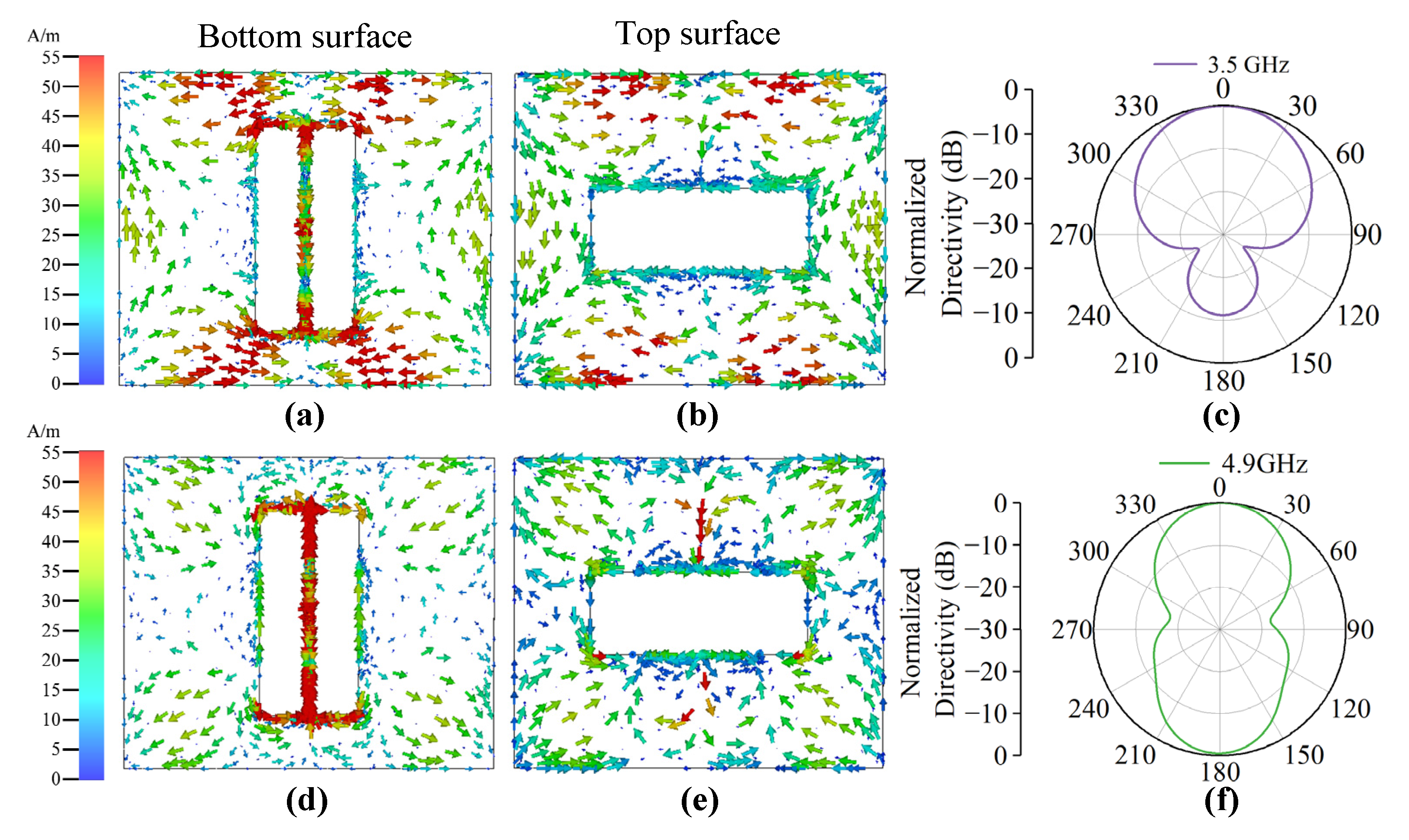
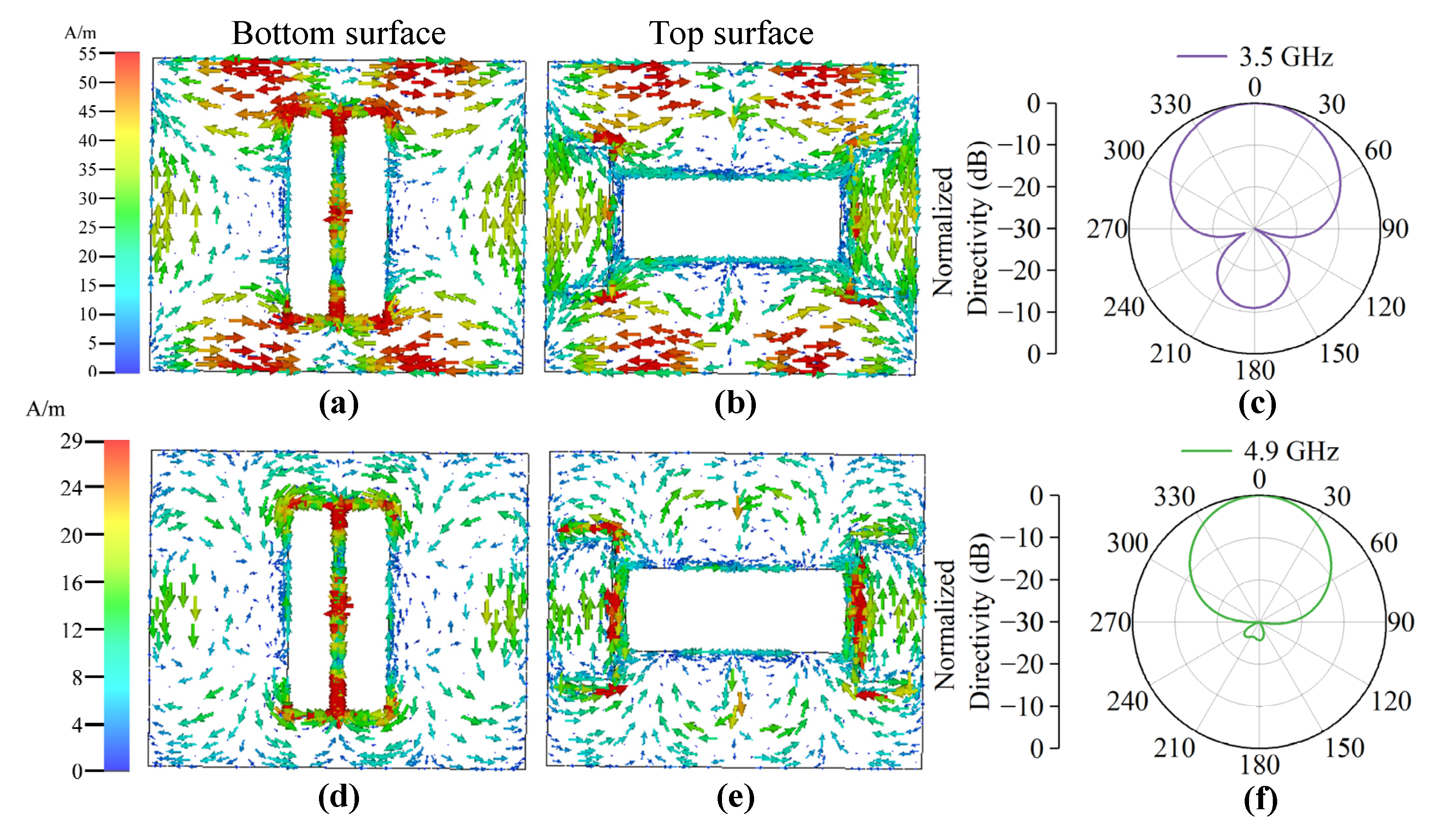


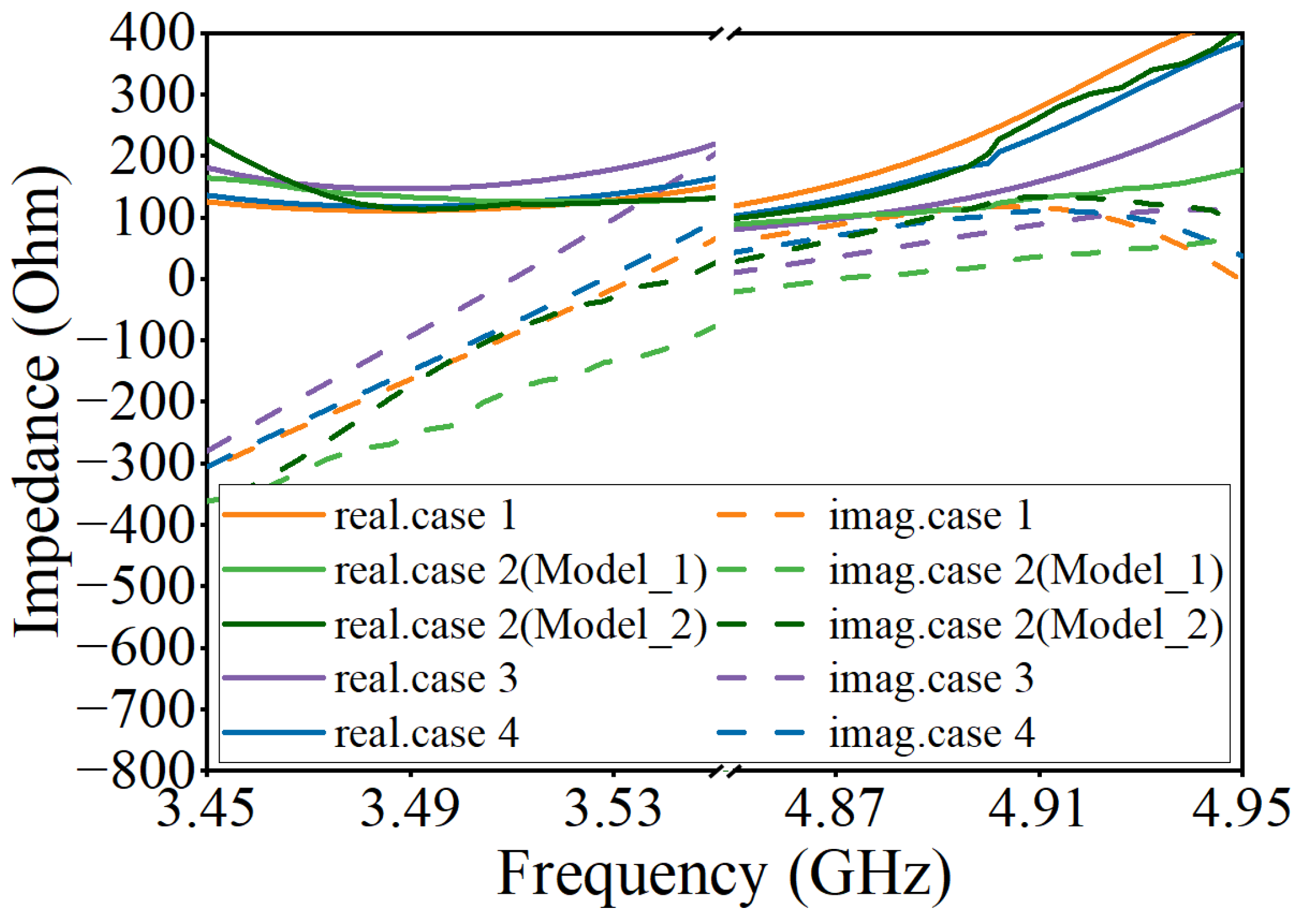

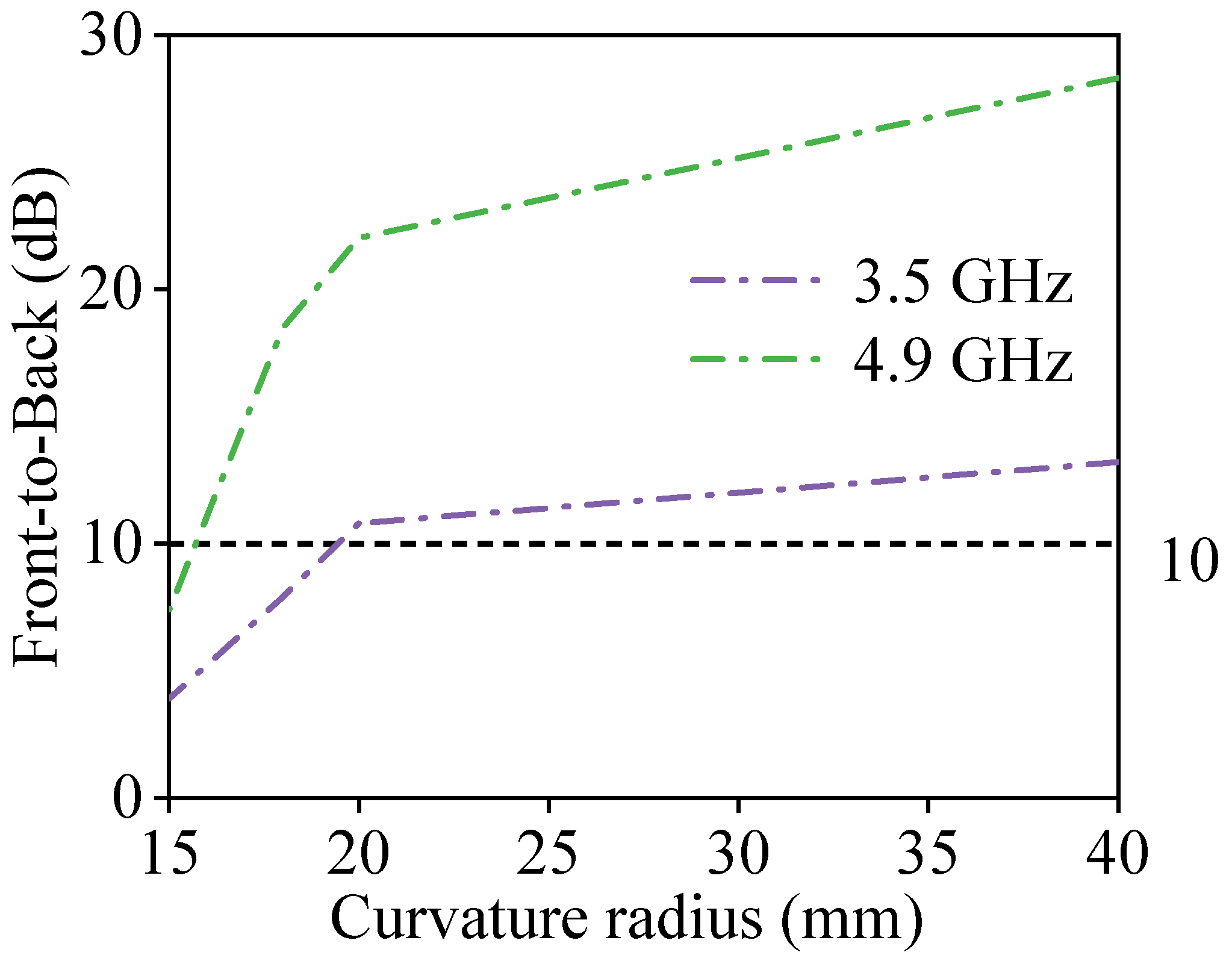

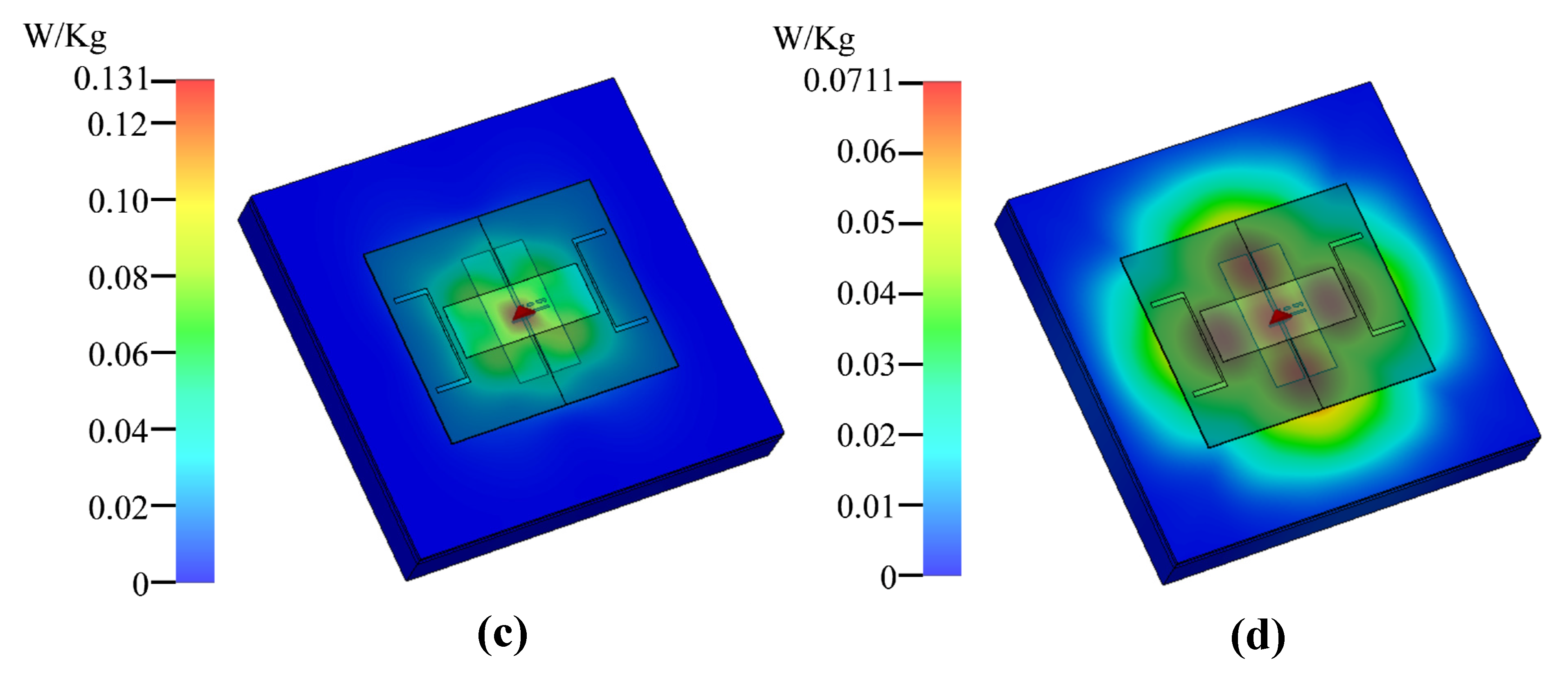

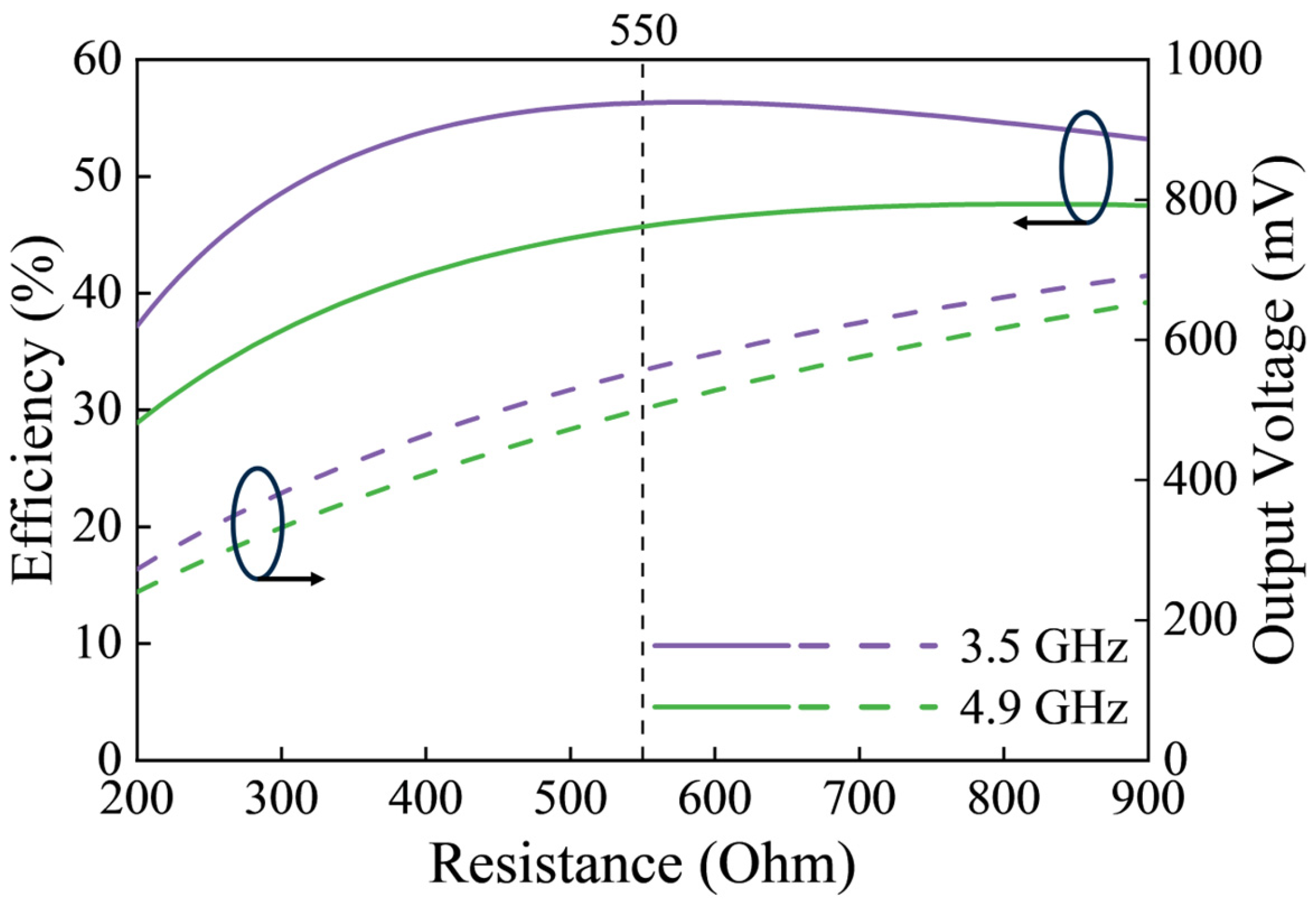


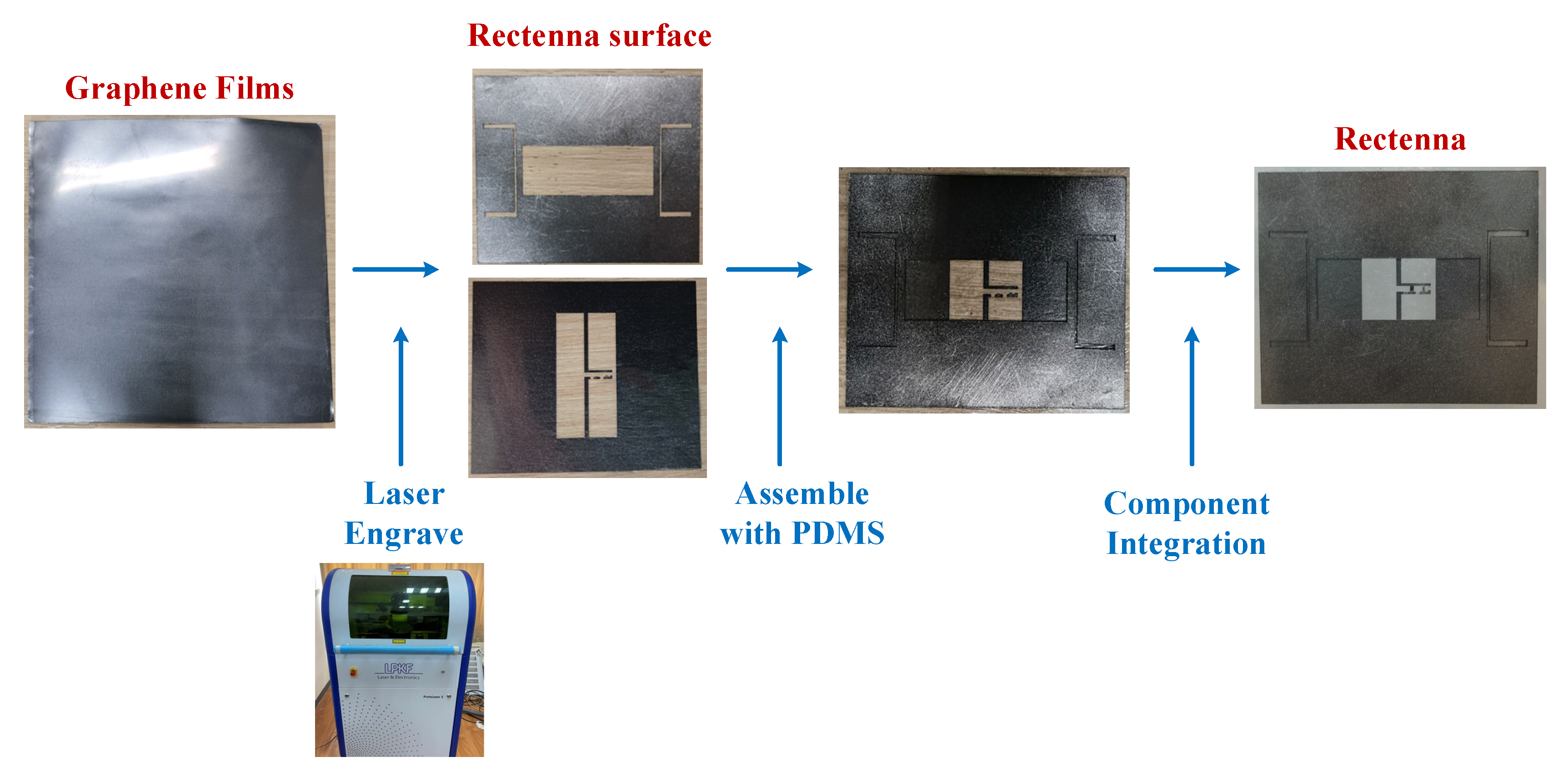
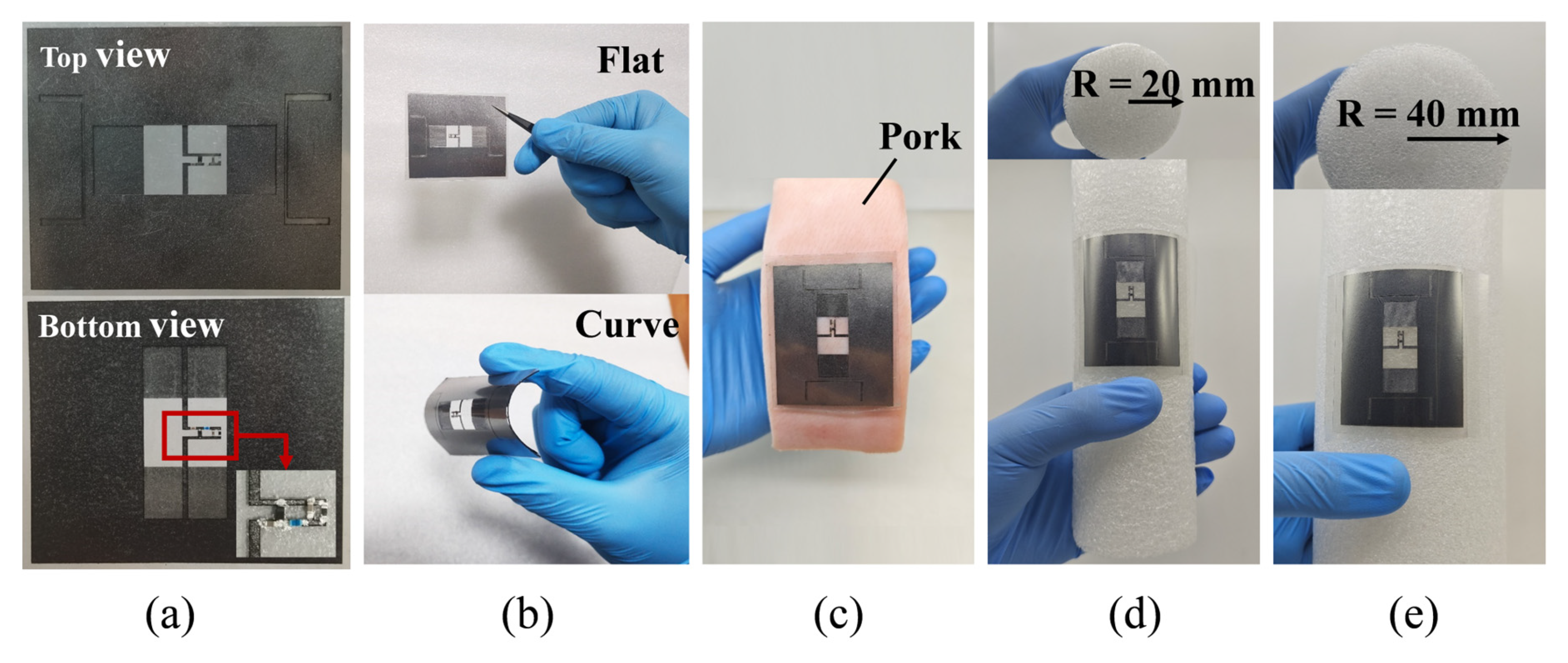


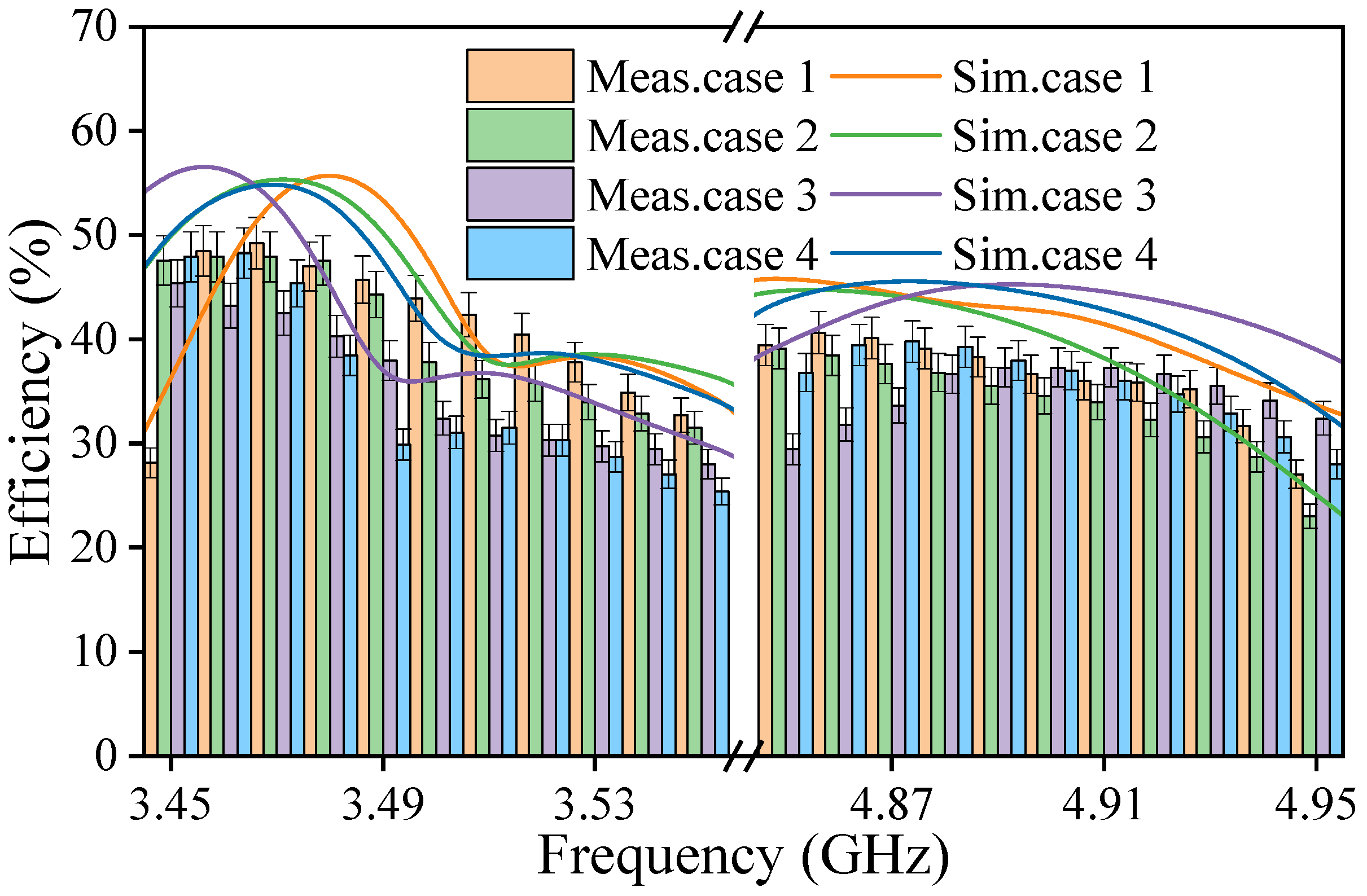


| Parameter | W1 | W2 | W3 | W4 | L1 | L2 | L3 | L4 |
| value | 47 | 12.5 | 31 | 23.4 | 56 | 33 | 15 | 52 |
| Parameter | S1 | S2 | S3 | S4 | S5 | h | ||
| value | 1.2 | 1 | 0.5 | 1.2 | 1.5 | 0.5 |
| Layer | Thickness (Model 1) | Thickness (Model 2) | Dielectric Const. | Electric Cond. | Density (Kg/m3) |
|---|---|---|---|---|---|
| Skin | 1 mm | 5 mm | 38 | 1.46 S/m | 1100 |
| Fat | 4.5 mm | 7 mm | 5.28 | 0.39 S/m | 1016 |
| Muscle | 7.5 mm | 30 mm | 52.7 | 1.88 S/m | 1006 |
| Frequency Band | Case 1 (CGF) | Case 1 (Copper) | Case 2 | Case 3 | Case 4 |
|---|---|---|---|---|---|
| 3.5 GHz | 48.2% | 67.8% | 46.6% | 49.9% | 49.1% |
| 4.9 GHz | 56.2% | 73.7% | 52.4% | 49.6% | 50.9% |
| L | 2.7 nH, LQW15AN2N7D0Z, chip inductor |
| C1 | 390 pF, GRM1555C1E391JA01, chip capacitor |
| C2 | 470 pF, GRM1555C1E471JA01, chip capacitor |
| Diode | SMS7630, Schottky diode |
| Ref. | Frequency Band | Number of Substrate Layer | Radiation Pattern | Size in λ0 | Corrosion Resistance | Peak Conversion Efficiency (%) |
|---|---|---|---|---|---|---|
| [15] | Single | Two | Directional | 0.75 × 0.75 | no | 56 @ −5dBm |
| [19] | Two | One | Omnidirectional | 0.29 × 0.61 | no | 40 @ 1 dBm/37 @ 0 dBm |
| [24] | Three | One | Omnidirectional | 0.34 × 0.07 | no | 70 @ 1 dBm/59 @ 3 dBm /50 @ 4 dBm |
| [25] | Four | One | Omnidirectional | 0.25 × 0.31 | no | 48 @ 5 dBm/50 @ 5 dBm /42 @ 10 dBm/34 @ 10 dBm |
| [28] | Single | Two | Directional | 0.57 × 0.52 | no | 56 @ −5 dBm |
| [30] | Single | Two | Directional | 0.82 × 0.16 | no | 49 @ 20 dBm |
| This work | Two | One | Directional | 0.65 × 0.54 | yes | 53 @ 4 dBm/47 @ 4 dBm |
Disclaimer/Publisher’s Note: The statements, opinions and data contained in all publications are solely those of the individual author(s) and contributor(s) and not of MDPI and/or the editor(s). MDPI and/or the editor(s) disclaim responsibility for any injury to people or property resulting from any ideas, methods, instructions or products referred to in the content. |
© 2025 by the authors. Licensee MDPI, Basel, Switzerland. This article is an open access article distributed under the terms and conditions of the Creative Commons Attribution (CC BY) license (https://creativecommons.org/licenses/by/4.0/).
Share and Cite
Sun, X.; Zhang, J.; Wang, W.; He, D. A Wearable Dual-Band Magnetoelectric Dipole Rectenna for Radio Frequency Energy Harvesting. Electronics 2025, 14, 1314. https://doi.org/10.3390/electronics14071314
Sun X, Zhang J, Wang W, He D. A Wearable Dual-Band Magnetoelectric Dipole Rectenna for Radio Frequency Energy Harvesting. Electronics. 2025; 14(7):1314. https://doi.org/10.3390/electronics14071314
Chicago/Turabian StyleSun, Xin, Jingwei Zhang, Wenjun Wang, and Daping He. 2025. "A Wearable Dual-Band Magnetoelectric Dipole Rectenna for Radio Frequency Energy Harvesting" Electronics 14, no. 7: 1314. https://doi.org/10.3390/electronics14071314
APA StyleSun, X., Zhang, J., Wang, W., & He, D. (2025). A Wearable Dual-Band Magnetoelectric Dipole Rectenna for Radio Frequency Energy Harvesting. Electronics, 14(7), 1314. https://doi.org/10.3390/electronics14071314






